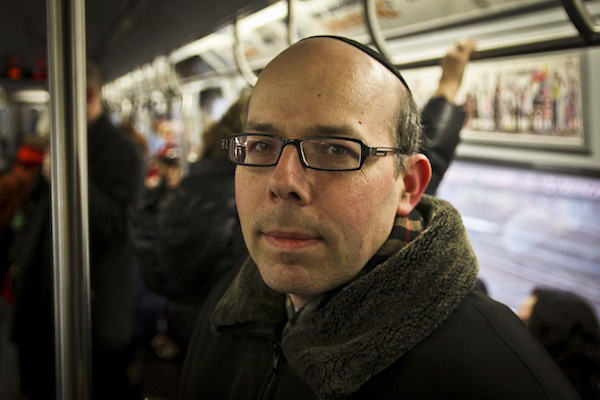
Photo by: Brock Stoneham
Abe Leitner rides the Q train from Brooklyn into Manhattan on Wednesday morning.
Scott Sachs doesn’t have to wonder if he can make the 4½-foot jump from the subway tracks back to the platform.
“One night I dropped my phone on the tracks and no one was around,” he said. “So, I popped down on the tracks, picked it up and climbed back onto the platform.”
After the recent death of Ki-Suck Han, a 58-year old Queens man who was pushed onto the tracks and then killed by a southbound Q train at 49th Street, many frequent subway riders said they’ve been more cautious on the platform.
“My senses are heightened when I’m there now,” Sachs, a rider on the N/Q line, said.
Other riders during a recent early commute – the ones who would talk to a reporter anyway – said that they, too, are paying more attention to safety.
“Before all the events of the people falling on the tracks, I would easily get impatient and pace along the yellow line, gazing down the tracks, “said Natali Naegle, a rider who said she now keeps her distance from the platform edge. “You can’t make the subway faster by standing on the edge, looking down the tunnel.”
Crime worries ebb
In response to the heightened concerns across the subway system, Manhattan Borough President Scott Stringer announced plans for a subway safety task force last week. The MTA also launched a “Stand Back. Be Safe. Be Smart.” campaign.
They new ads offer statistics about how often riders are struck by trains – 146 people in 2011 and 141 people in 2012 – and implore everyone to stand back. Subway deaths were up by 8 in 2012 with 55 people killed by trains.
But given the millions of rides the subway provides every day, instances of people falling, jumping or being pushed onto the tracks are rare. For most commuters, being robbed or assaulted has always been a more likely fear. But that fear has abated amid a crime reduction underground.
Despite the occasional headlines detailing subway violence, several longtime New Yorkers riding the train – despite their complaints about unclean stations, infrequent trains and too little space – feel safer today than they have in decades.
Abe Leitner, who takes the Q train every morning from Brooklyn into Manhattan, said that fights and drunks used to be commonplace. “I’ve been commuting for 20 years,” said Leitner. “The biggest difference now is I feel comfortable traveling off-hours. It used to be that you saw a lot of sketchy people on the train at those times, but now I feel totally safe.”
The change in the apparent safety is even more pronounced to those who haven’t ridden the subway in years. Donald Redd, 51, a resident manager in Brooklyn who hasn’t lived in the borough since the 1980s, was taking the train this week only because his car broke down. He hadn’t ridden the subway once since moving to Jersey City three years ago.
“I tell you from when I used to be here, it used to be dirty and bitter and covered in graffiti,” Redd said. “It’s come a long way, I can see that.”
Mark Burzynski recalled a recent commute when a man standing nearby started making noise, acting belligerent and telling strangers not to look at him. People moved away if they could.
“He picked out this one guy in the crowd,” said Burzynski, 42, who works in the art department on film productions. “It eventually escalated, and the crazy guy made a move, and it turned out that the guy he chose to pick on, out of all the people there, was a police officer, undercover.”
Two more officers appeared, and the belligerent man’s demeanor changed immediately. Burzynski said, “Once the cop pulled out his badge, the guy sat down and everybody was laughing at him.”
But not every commuter’s experience is one of increased safety. Angel Caldwell, who takes the J train, recalled a chilling episode.
“The last time I fell asleep on the train I woke up with by back pocket slashed and my wallet stolen,” said Caldwell. “I’d like to see more cops on the train.”
Changes made, sought
Alex Alemayhu, a regular on the N and Q, hasn’t changed his demeanor on the platform and still looks over the edge.
“I’ve been living in New York since 1989,” he said.
But many riders said there were more aware about their proximity to the track these days. Michael Nilsson likes the elevated lines of the N and Q trains in Queens because they allow riders to see incoming trains even if they’re standing against the wall. Like many New Yorkers, Nilsson said in recent months he’s been more vigilant on the platforms.
Samantha Norris said she’s always thinking, “what if it could happen to me” and leaves one headphone out to remain alert on the platform.
Macy Tsui, an accountant, commutes on the subway to her office in Midtown daily. She wants the MTA to put doors between riders and tracks, similar to those in her native Shanghai. The doors would retract only when a train has safely approached the station.
The MTA has looked into installing platform doors, but that would require significant upgrades.
“They could spend the money,” said Tsui. “The subway system here is old.”








